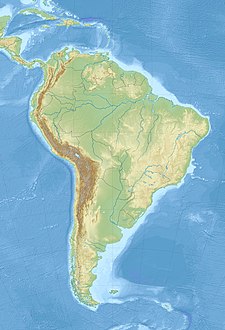Boreostemma
| Boreostemma Temporal range: Mid Miocene-Early Pliocene (Laventan-Montehermosan) ~13–5 Ma PreꞒ Ꞓ O S D C P T J K Pg N | |
|---|---|
 | |
| Tail of Boreostemma from the Honda Group | |
| Scientific classification | |
| Domain: | Eukaryota |
| Kingdom: | Animalia |
| Phylum: | Chordata |
| Class: | Mammalia |
| Order: | Cingulata |
| Family: | Chlamyphoridae |
| Subfamily: | †Glyptodontinae |
| Genus: | †Boreostemma Carlini et al. 2008 |
| Type species | |
| †Boreostemma pliocena Carlini et al. 2008 | |
| Species | |
| |
Boreostemma is an extinct genus of glyptodonts from northern South America. Fossils assigned to the genus were first described as belonging to Asterostemma from southern South America, but have been placed in the new genus Boreostemma by Carlini et al. in 2008. The type species is B. pliocena. Fossils of Boreostemma have been found in the Honda Group of Colombia, in Peru and Venezuela.
Etymology
The genus name Boreostemma is a combination of stemma, taken from Asterostemma, and boreo is derived from borealis, meaning "northern", to distinguish the northern South American genus from the southern Asterostemma.[1]
Taxonomy
Boreostemma has been placed as closely related to the later Glyptodon and Glyptotherium. Cladogram after Barasoain et al. 2022[2]:
| Glyptodonts |
| |||||||||||||||||||||||||||||||||||||||||||||||||||||||||||||||||||||||||||||||||
Species







 Asterostemma
Asterostemma B. acostae & B. gigantea
B. acostae & B. gigantea B. pliocena (type)
B. pliocena (type) B. venezolensis
B. venezolensis Boreostemma sp.
Boreostemma sp.Four species have been described in the genus Boreostemma.[3] Unspecified Boreostemma fossils were found in the Ipururo Formation of the department of Ucayali, Amazonian Peru.[4][5][6] Asterostemma contains the type species A. depressa and several nomina dubia. The genus has been found in the Early Miocene (Santacrucian in the SALMA classification) Santa Cruz Formation of the province of Santa Cruz, Argentina and in the Solimões Formation in the state of Acre, Amazonian Brazil.[7][8]
- B. pliocena
The type species B. pliocena was described in 2008 by Carlini et al. based on 30 osteoderms palate fragment with M6-7 alveoli.[9] Fossils have been described from the type locality along the road to Tío Gregorio in the Codore Formation at the Lagerstätte of Urumaco.[10]
- B. gigantea
B. gigantea was described as Asterostemma gigantea in 1997 by Carlini et al. based on a partial skeleton.[11] Fossils have been recovered at the Duke Localities 32, 108, 113, 114 and 121W in the La Victoria Formation of the Honda Group at the Konzentrat-Lagerstätte La Venta.[12][13][14][15][16]
- B. acostae
B. acostae was described as Asterostemma acostae in 1983 by Carlos Villarroel based on a carapace fragment with 44 plates.[17] Fossils have been found in the Cerbatana Member, and the Chunchullo Sandstone of the La Victoria Formation, of the Honda Group at the Konzentrat-Lagerstätte La Venta.[18][19]
- B. venezolensis
B. venezolensis was described as Asterostemma venezolensis in 1947 by George Gaylord Simpson,[20] based on most of the carapace and the anterior end of the lower jaw, including teeth.[21] Fossils have been uncovered from the Santa Inés Formation along the banks of the Güere River in the state of Anzoátegui in Venezuela.[22]
Gallery
-
 Carapace of Boreostemma
Carapace of Boreostemma -
 Reconstruction
Reconstruction
See also
References
- ^ Carlini et al. 2008, p. 142.
- ^ Barasoain, Daniel; Zurita, Alfredo E.; Croft, Darin A.; Montalvo, Claudia I.; Contreras, Víctor H.; Miño-Boilini, Ángel R.; Tomassini, Rodrigo L. (June 2022). "A New Glyptodont (Xenarthra: Cingulata) from the Late Miocene of Argentina: New Clues About the Oldest Extra-Patagonian Radiation in Southern South America". Journal of Mammalian Evolution. 29 (2): 263–282. doi:10.1007/s10914-021-09599-w. ISSN 1064-7554. S2CID 245945029.
- ^ Boreostemma at Fossilworks.org
- ^ IN-DTC-28 at Fossilworks.org
- ^ IN-DTC-32 at Fossilworks.org
- ^ IN007 at Fossilworks.org
- ^ Cañadón Jack, Yak-Harvey at Fossilworks.org
- ^ Rio Acre at Fossilworks.org
- ^ Boreostemma pliocena at Fossilworks.org
- ^ Road to Tio Gregorio Locality at Fossilworks.org
- ^ Boreostemma gigantea at Fossilworks.org
- ^ Duke Locality 32 at Fossilworks.org
- ^ Duke Locality 108 at Fossilworks.org
- ^ Duke Locality 113 at Fossilworks.org
- ^ Duke Locality 114 at Fossilworks.org
- ^ Duke Locality 121W at Fossilworks.org
- ^ Boreostemma acostae at Fossilworks.org
- ^ Arcillas San Nicolas at Fossilworks.org
- ^ Chunchullo Sandstone at Fossilworks.org
- ^ Simpson, 1947, p.2
- ^ Boreostemma venezolensis at Fossilworks.org
- ^ Banks of the Güere River at Fossilworks.org
Bibliography

- Carlini, Alfredo A.; Alfredo E. Zurita; Gustavo J. Scillato Yané; Rodolfo Sánchez, and Orangel A. Aguilera. 2008. New Glyptodont from the Codore Formation (Pliocene), Falcón State, Venezuela, its relationship with the Asterostemma problem and the paleobiogeography of the Glyptodontinae. Paläontologische Zeitschrift 82. 139–152. Accessed 2017-09-26.
- González Ruiz, Laureano R.; Martin R. Ciancio; Gabriel M. Martin, and Alfredo E. Zurita. 2014. First record of supernumerary teeth in Glyptodontidae (Mammalia, Xenarthra, Cingulata). Journal of Vertebrate Paleontology e885033. 1–6. Accessed 2017-09-26.
- González, Laureano Raul. 2010. Los Cingulata (Mammalia, Xenarthra) del Mioceno Temprano y Medio de Patagonia (edades Santacrucense y "Friasense") revisión sistemática y consideraciones bioestratigráficas (PhD thesis), 1–468. Universidad Nacional de La Plata. Accessed 2017-09-26.
- Simpson, George Gaylord. 1947. A Miocene glyptodont from Venezuela. American Museum Novitates 1368. 1–10. Accessed 2018-10-01.
- Zurita, Alfredo E.; Laureano R. González Ruiz; Arley J. Gómez Cruz, and José E. Arenas Mosquera. 2013. The most complete known Neogene Glyptodontidae (Mammalia, Xenarthra, Cingulata) from northern South America: taxonomic, paleobiogeographic, and phylogenetic implications. Journal of Vertebrate Paleontology 33. 696–708. Accessed 2017-09-26.
- v
- t
- e
| 
 | |||||||||||||||||||||||||||||||
























